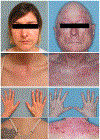Evaluating important change in cutaneous disease activity as an efficacy measure for clinical trials in dermatomyositis
- PMID: 31206600
- PMCID: PMC6917999
- DOI: 10.1111/bjd.18223
Evaluating important change in cutaneous disease activity as an efficacy measure for clinical trials in dermatomyositis
Abstract
Background: Patients may experience improved quality of life (QoL) without complete clearance of skin disease. The Cutaneous Dermatomyositis Disease Area and Severity Index Activity (CDASI-A) score correlates with the Symptoms and Emotions subscales of Skindex-29, a measure of QoL, down to CDASI-A scores of 7 points (for Symptoms) and 10 points (for Emotions).
Objectives: Our goal was to define an important change in disease activity, as measured by the CDASI-A, that results in a meaningful change in QoL in patients with dermatomyositis.
Methods: In 103 patients, we assessed the percentage change and actual change in CDASI-A scores needed to achieve a meaningful improvement in QoL, using linear regression models.
Results: We found that meaningful improvement correlates with 7·86 points (P < 0·001) in Symptoms, and 10·29 points (P < 0·001) in Emotions, after correlating Skindex-29 to an established definition of meaningful change in the Dermatology Life Quality Index (DLQI). For patients with initial CDASI-A scores > 14 points, a 40% change in CDASI-A between the first two visits suggests a meaningful change in Skindex-29. In patients with moderate initial CDASI-A (15-26 points), the changes in CDASI-A resulting in meaningful changes in Symptoms and Emotions were 6 points (P < 0·001) and 7 points (P < 0·001), respectively. For initial CDASI-A scores in the severe range (27-35 points), an improvement in CDASI-A by 11 points (P = 0·030) and 9 points (P = 0·021) leads to a meaningful change in Symptoms and Emotions, respectively.
Conclusions: In patients with an initial CDASI-A score > 14 points, a 40% change in the CDASI-A score can be used to indicate a meaningful change in QoL in future dermatomyositis trials. What's already known about this topic? The Cutaneous Dermatomyositis Disease Area and Severity Index (CDASI) is a validated disease assessment tool used to capture the extent of cutaneous activity and damage. The Skindex-29 and Dermatology Life Quality Index are standardized and validated measures of quality of life (QoL) for clinical trials and correlate with CDASI Activity (CDASI-A) scores. What does this study add? We identified what change in Skindex-29 scores over two consecutive visits would indicate an important change (a minimal clinically important difference) in QoL. We determined which change in CDASI-A scores over two consecutive visits would lead to a meaningful change in QoL. For patients with an initial CDASI-A score > 14 points, a 40% change in the CDASI-A score over two visits is associated with a meaningful change in QoL. What are the clinical implications of this work? Clinical trials can consider using a 40% change in the CDASI-A score as an end point when assessing the clinical efficacy of drugs.
Published 2019. This article is a U.S. Government work and is in the public domain in the USA.
Figures
Comment in
-
Outcome measures in dermatomyositis: quality of life and the patient perspective.Br J Dermatol. 2020 Apr;182(4):830-831. doi: 10.1111/bjd.18600. Epub 2019 Nov 8. Br J Dermatol. 2020. PMID: 31705532 No abstract available.
References
-
- Findlay AR, Goyal NA, Mozaffar T. An overview of polymyositis and dermatomyositis. Muscle Nerve 2015; 51: 638–56. - PubMed
-
- Gaffney R, Tarazi M, Feng R et al. Examining cutaneous disease activity as an outcome measure for clinical trials in dermatomyositis. Journal of the American Academy of Dermatology 2019. - PubMed
-
- Basra MK, Salek MS, Camilleri L et al. Determining the minimal clinically important difference and responsiveness of the Dermatology Life Quality Index (DLQI): further data. Dermatology 2015; 230: 27–33. - PubMed
Publication types
MeSH terms
Grants and funding
LinkOut - more resources
Full Text Sources
Other Literature Sources


